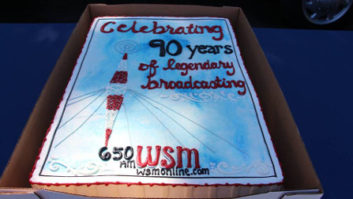A medium-size broadcaster who operates several radio and television stations told us that he received over $700,000 a year from tower leasing activities, a line of business he had not promoted.
However, this broadcaster received no revenue from leasing space on his AM towers because he was unaware that existing technology allows collocating wireless service providers on most single and multiple AM towers without impairing their performance.
(click thumbnail)Photos courtesy Cavell Mertz & Associates Inc.
Like this medium-size broadcaster, many broadcast and wireless engineers are unfamiliar with leasing space on AM towers to cellular, PCS, Enhanced Specialized Mobile Radio Service and other wireless service providers. Carriers have been more likely to put a new wireless tower near AM stations rather than try to collocate on AM towers.
When they build the new tower, wireless tower owners are required by the FCC to ensure that the AM pattern is not compromised by re-radiation from the structure. Sometimes it is an independent tower company that wants to build a tower and generate rental revenue from the wireless carriers — at the expense of potential income to a nearby AM tower owner.
Where the wireless carrier elects to build a tower, new service can be delayed due to zoning issues and complaints by anti-tower interests. In other cases, it is the wireless carrier itself, thinking that it will be cheaper and easier to install a new tower than to collocate on an AM tower.
Such thinking has resulted in lost opportunities for AM licensees to receive a steady stream of recurrent revenues that increase each year over a long period of time.
Revenue
Leasing space on an AM tower can be a significant source of continuing and escalating revenue. Rents often exceed $2,500 per month per carrier for desirable sites and some AMs can accommodate several carriers on a single tower.
(click thumbnail)AM tower hosting wireless antennasRick Edwards, president of Tower America, reports that he has added collocators to AM arrays that in one instance created revenues of over $500,000 a year and resulted in over $11.2 million in revenues during the term of the lease. The carrier paid construction and engineering costs.
Eddie Esserman, a broker with Media Services Group, told us about the experience of an AM station in southeastern Georgia. A large wireless carrier needed tower space but didn’t want to build its own cell tower in a small picturesque community where zoning was problematic.
Instead, the carrier leased space on the AM tower. However, before installing its antennas, the carrier rebuilt the structure, re-guyed the site, installed a new ground system, added lighting, built a fence and proofed the finished system — at a cost of $100,000. The AM station received the first year’s rent in advance. It also discovered that the site modifications improved the station’s signal.
With regard to legal considerations, the 1996 Telecommunications Act made it clear that states or municipalities may not unreasonably delay requests to place, construct or modify towers used for mobile private and common carrier wireless communications. The legislation also spelled out an appeal process and enacted other reforms, all designed to assist the wireless industry.
In fact, municipalities often require wireless companies to utilize existing towers, including AM towers, instead of building new ones. Collocation should enable the carrier to jump fewer regulatory hurdles than for a new tower, such as compliance with federal environmental restrictions governing locating in wetlands or migratory birds, and local land use restrictions, as well as objections by residential and environmental groups.
While it is true that zoning laws in some jurisdictions may prohibit adding to towers, many AM towers in urbanized areas have been standing for decades. So carriers seeking to eliminate gaps in coverage usually can collocate under the broadcaster’s existing permits.
(click thumbnail)Busy grounded tower baseCollocation is now practical for both single and multiple tower systems. Radio engineers have overcome the traditional obstacles to this technique while permitting virtually unlimited wireless users on most AM towers.
Collocation requires modifying the feed characteristics of the AM tower (from series-fed to shunt-fed) without affecting efficiency, or installing specialized hardware to feed the wireless signals to the hot tower. Since the tower is a radiating element and wireless antennas and coaxial cable are self-contained systems, physical connection to the AM antenna is easily accomplished in most cases whether the station is directional or non-directional.
For example, in a multi-tower array, carriers that want to improve coverage in different directions can use more than one structure. Once a system is installed, tuned up and proofed, wireless antennas and coaxial cables attached to the towers have virtually no effect on the host AM station’s signal.
Loading
The most critical factor that must be addressed up front is the structural loading of the new antennas and cables placed on the tower (wind and weight loading).
Many loading issues can be addressed by tower reinforcement, re-guying the tower or full replacement of the tower with a sturdier one — all at the expense of the new tenant.
Moreover, while ANSI/EIA/TIA-222 G’s (“Rev G”) design criteria for steel towers may not be mandatory for tower changes, insurers may nevertheless require compliance with the new standards since they affect tower safety. The fact remains that some older AM towers simply cannot accommodate sectorized wireless antennas and modifications may not be feasible.
To be sure, every AM station is unique and its ability to host wireless antennas will vary. However, most AM towers can handle wireless antennas, which generally are lightweight and compact, and special shunt-fed and wire-skirt techniques that ground the tower base permit those antennas to be maintained while the AM station is broadcasting.
Nevertheless, some AM situations may not readily adapt to these changes without impeding the broadcast signal. Where such is the case, collocating could require more complex solutions that may not be sufficiently economical to appeal to a wireless carrier. As with any complex engineering project, experienced technical and legal experts should be working for the broadcaster beginning at the earliest stages of such a project.
The bottom line is that AM broadcasters can fatten their bottom lines if they are able to attract wireless tenants and to negotiate favorable leases.
This article is based on a chapter in “Broadcast Towers: A Step-by-Step Guide to Vertical Real Estate,” published by the National Association of Broadcasters, www.nabstore.com.












